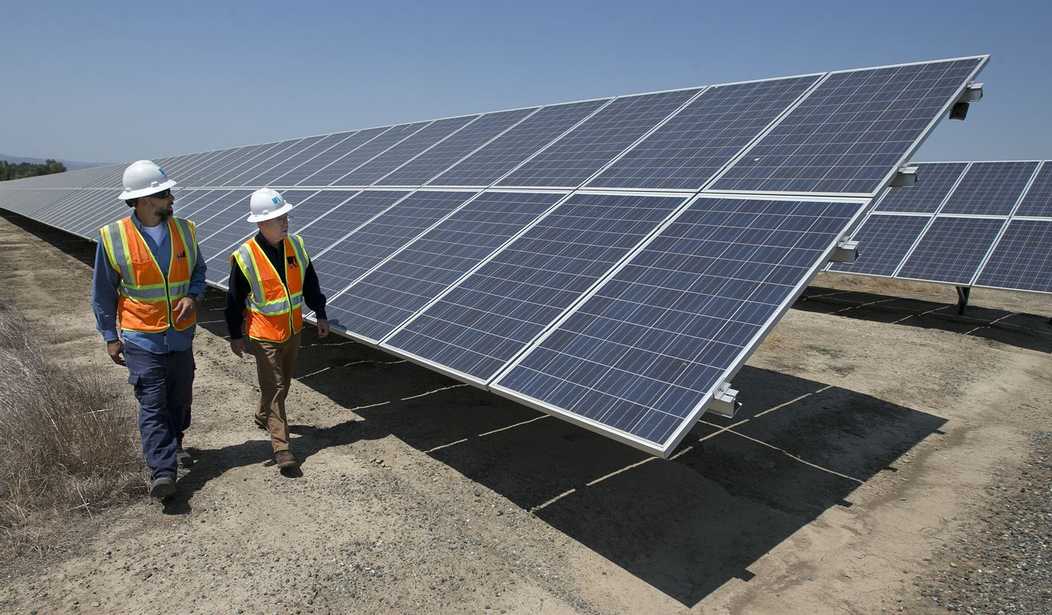The Biden administration has sunk billions of taxpayer dollars into “renewable” energy, but a new report won’t surprise Americans who’ve read any honest research on solar panels. It reveals that the panels are nearly as carbon-intensive as natural gas. Not only that, investment in solar benefits America’s number one enemy: China.
Twitter Files journalist Michael Shellenberger shared the analysis from C.P. Colum and Lea Booth on Twitter. The research, published as “Solar Panels Are Three Times More Carbon-Intensive Than IPCC Claims,” was conducted in collaboration with Environmental Progress and The Blind Spot.
Joe Biden’s Inflation Reduction Act funneled billions of Americans’ tax dollars to renewables last year as part of “Build Back Better.” Calum and Booth report:
What few backing the bill realized was that the largest beneficiary would likely be China due to its expansive grip on the global solar photovoltaic (PV) industry. Worse than that, it might end up misdirecting the world’s clean energy efforts into dirtier than appreciated energy technologies because of the country’s ongoing dependence on coal-fired energy.
Information unearthed by Environmental Progress, a nonprofit research organization, points to a gaping oversight in how the figures influencing government net zero policy and investments in solar worldwide are compiled and collated due to the difficulty of collecting accurate information out of China, especially for the purification processes used to create silicon wafers.
Only a few data compilers provide the majority of the source material, Colum and Booth explained. Most or even all of these compilers work with the International Energy Agency (IEA), using anonymous, voluntarily submitted data. The anonymous aspect can create conflicts of interest, Colum and Booth noted.
Exclusively for our VIPs: Biden Admin Pushes Solar Panels — While Looking to Block Sunlight?!
They also detailed a “further puzzle” regarding Swiss-based nonprofit Ecoinvent, that somehow gets the data for what it calls “the world’s most consistent and transparent life cycle inventory database.” Institutions globally use Ecoinvent’s data to calculate their supposed carbon footprint.
Colum and Booth gave a technical explanation of solar photovoltaic (PV) estimates, and how a new investigation from Italian researcher Enrico Mariutti indicates solar panel PV “would not compare favorably with natural gas.” That means solar panel carbon intensity isn’t comparably better than the much-vilified natural gas.
I’ve reported multiple times on how solar panels generate lots of toxic waste. In fact, solar panels have killed billions of birds. Meanwhile, huge swathes of natural scenery and farmland must be ruined to set up solar panels. Solar is damaging to the environment and it is unreliable.
And apparently, communist China also largely controls the manufacture of the panels.
Colum and Booth note the key fact that Ecoinvent doesn’t have the PV data for China — which is the world’s biggest polluter. Furthermore, “IEA’s supposedly public data on PV carbon intensity is confidential.” That makes the data unverifiable.
Much of the cradle-to-grave carbon intensity data that governments depend on to guide photovoltaic arrays are instead based on modeling assumptions that are likely to have grossly under-estimated — if not made up — solar’s carbon emissions because they cannot get insights from Chinese manufacturers.
In its most recent report, the IEA predicts that China will continue to dominate solar energy production, delivering over 50 percent of solar PV projects globally by 2024. This trajectory is especially concerning given that China already commands most solar panel production.
China’s global share of PV production increased exponentially in a short amount of time, from 14% in 2006 to 60% in 2013, Colum and Booth wrote. By 2021, “China produced more than 80 percent of global solar-grade polysilicon, a critical input into solar arrays.” Now, China makes a whopping 97% of the world’s solar wafers. The CCP’s manufacturing capacity went up between 40% and 50% for wafers, modules, and cells just in 2022.
America, Japan, and Germany used to dominate the market, but communist China’s ability to use government subsidies cheap coal energy and human labor (in poor conditions) allowed its sudden surge to dominance.
The lesson? The Biden administration shouldn’t be investing tax dollars in solar panels. They’re unreliable and far more carbon intensive than many like to admit. And investment in solar panels inevitably ends up benefiting the Chinese Communist Party.










Join the conversation as a VIP Member